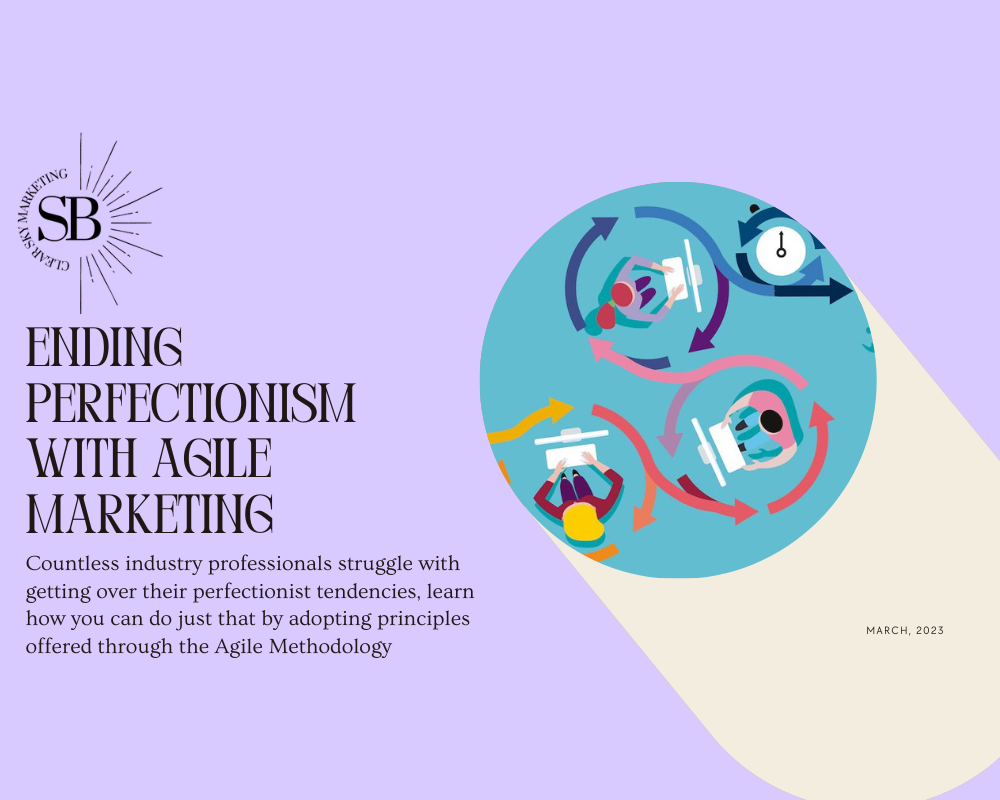Perfectionism: refusal to accept any standard short of perfection.
Many professionals, including myself, are haunted by this little thing called “perfectionism,” so much so that it creates a crippling sense of anxiety which can lead to delays and missed deadlines. Perfectionism especially in a group setting can become extremely hindering, as you are not only holding yourself to unreasonable expectations but also the people you are working with. The idea of a project or the result of something being “perfect” oftentimes means that there is an idealized perception of what the end project is going to be, and if the end project does not match that idea or plan then this can lead to dissatisfaction and a lack of productivity within the group, as well as a limitation to creativity as you are confined to the bounds of what you view as perfect.
In order to address the common issue of perfectionism, I want to introduce you to the Agile Marketing Manifesto. In short, Agile is a strategy consisting of key values and principles that influence fast and effective decision making skills.
One of the first of many valuable concepts I took away from the Agile methodology is to “deliver value early and often over waiting for perfection.” What stuck out to me when I was first introduced to this principle was the idea of “waiting for perfection,” and that is when I realized that through each group or individual project throughout my academic career, I was waiting for something that was never going to come to be. There is no reason to hold yourself to a standard you can never achieve, but with Agile you will see satisfying results early and often!
Rather than having a pre-defined end result for a project, the Agile methodology breaks a project into several different phases in which collaboration and continuous improvement take place at every stage. Reframing the way in which you approach a project with agile, rather than perfectionism allows you and your team members to respond to change over following a static plan. Many people who consider themselves to be a perfectionist think the path to success is a straight line, but that is far from the truth. By breaking a project into several different sections, often referred to as “sprints” which last about one to four weeks, teams can assess the performance of each sprint allowing for continuous improvement. Teams are given the opportunity to efficiently spot bottlenecks and appropriately address the issue. In opposition, when leading a project with a perfectionist mindset, there are limited opportunities to assess performance and it can be “too late” to fix something resulting in wasted time and resources.
Agile works to formulate a project life-cycle, rather than a streamlined or big-bang approach that usually stems from a perfectionist mindset. Here are some basic Agile steps to follow the next time you start a project, and I promise that results will follow!
- Start with a user story or a clear description of the goals of the project, and what the client hopes to gain.
- Define the tasks that must be completed to satisfy the needs of the client
- Allocate one to three weeks for each “Sprint” to work together on completing the defined tasks
- At the end of each Sprint, conduct a “Sprint Analysis” in which you evaluate what is working and what isn’t. This analysis allows you to make adjustments to the process which will be carried out in the following Sprint.
- Sprints and Sprint Analyses will continue until your product is ready to be distributed to the client!
Although this is a brief introduction to the Agile Methodology, it is important for me to mention that the success of Agile stems from the fluidity and flexibility of the process. Unlike perfectionism, Agile insists upon change and adaptation to most effectively satisfy the needs of the client or the purpose of the project. I am going to provide some other resources and tools that you can utilize as you begin to make your transition from perfectionism to Agile!

